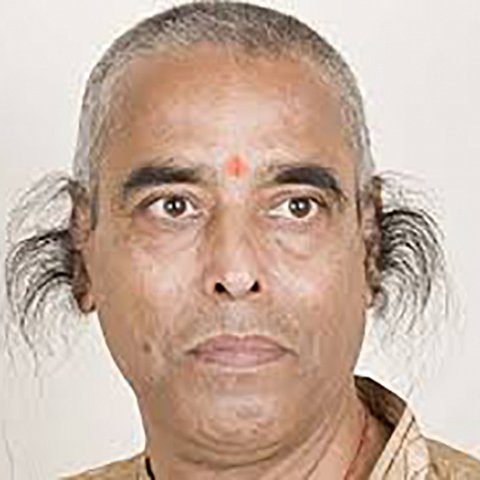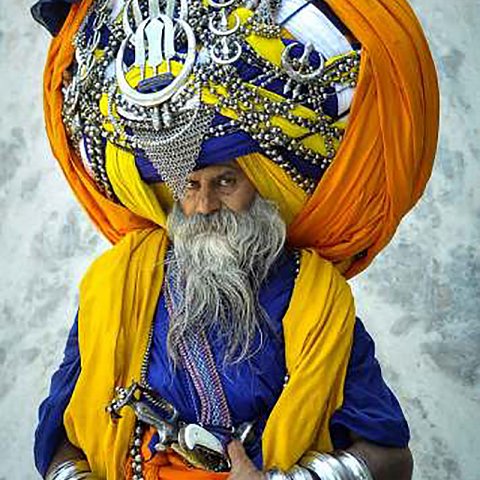Hair today, gone tomorrow?
This is not just a fashion preference of course, but an article of faith introduced by their tenth and last guru, Gobindh Singh around 1700.
The brotherhood was facing persecution from the Mughals, and the guru decreed that uncut hair was a public statement that its wearer belonged to the Sikh nation and was prepared to stand up and defend the faith. The turban was also a protection against assault. Gobindh Singh also ordained all male Sikhs should take the name singh, meaning ‘lion’. This is itself a traditional name in martial communities, so whereas all Sikhs are singh, not all singhs are Sikhs. Anyway, mutatis mutandis, here in the south, it is moustaches rather than full beards that have traditionally been the sign of a warrior caste or warlike temperament. As such they are often worn by the sculpted door-guardians that flank the entrance of a Hindu temple, where they signify the power to scare off unwanted negative energies.
However, it appears that India’s legendary facial hair is fast disappearing as the country enters the clean-shaven digital age. Previously it set records: hirsute Hindustan boasted the world’s longest beard (five feet) and the world’s longest industrial tribunal (several years) which involved the requested, and repeatedly refused, removal of a moustache. But now luxuriant growths are being replaced by self-conscious fears that a moustache or beard looks rather untidy and scratchy or even worse, makes a young man look older. In a country where to maintain an appearance of virility huge numbers of men routinely dye their hair – a visit to the barber’s usually ends with the shameless proffering of what looks like a Dulux colour chart to chose your top-up tint - premature follicle ageing is bad news indeed. So role models are taking to the razor at an alarming rate: famous cricketers no longer sport facial hair, while even Bollywood stars have opted instead for the half-hearted compromise of designer stubble. A recent poll among Indian women suggested that the age of ‘barbarians’ is on the way out; if you can’t be a proper metro-man then they judged the most acceptable to be a neatly trimmed goatee, such as worn by that grand old man and omnipresent icon of Indian cinema, Amitabh Bachchan, popularly known and adored as ‘The Big B’
It is said that moustaches received a boost during the days of the Raj, when British army officers with their naked upper lips had difficulty maintaining authority among the native troops who equated this lack of plumage with a lack of manliness. Once the army began cultivating moustaches, the trend spread quickly through the ranks and then beyond the cantonement walls into the civilian population. The style continued for both military and civil authorities and in the national psyche a hirsute upper lip became instantly recognizable as a badge of authority. One of the best loved Hindi movies of all times, the 1979 social comedy Gol Maal - ‘Hodgepodge’- satirises this attitude with a story about an authoritarian boss who considers men without moustaches to be spineless and so insists that all his staff wear one. Growing moustaches, like putting creases in mens’ jacket sleeves, seems to be one Raj military habit the Indians just can’t kick.
In these recent times of turbulent change however, the fashion does unfortunately appeared to have seriously waned. For some time even the country’s police force has no longer required its officers to sport a bushy upper lip; in fact the only profession where a moustache continued to be mandatory was that of a doorman at a five-star hotel, who is presumably the modern version of one of those protective temple guardians. But things may be changing, as according to latest reports, the good old days of the 1970s Burt Reynolds look may be on the way back. We hear that in Madhya Pradesh policemen are now being encouraged to grow moustaches once more as a means to improve their authority and social status. The incentive is that facially hirsute officers will be paid an extra 30 rupees a month but only on the condition that their whiskers conform to a shape deemed appropriate. Quite right too.
These subcontinental ups and downs conform with the international pattern that as soon as a trend becomes really popular, the style-set tend to abandon it as old hat. In the West, moustaches have been suspect for some time, but the latest trend for beards began more than five years ago. Many of the usual suspects – soccer dad and fashion accessory David Beckham, moody Hollywood heartthrob Ryan Gosling, ZZ Top rocker Patrick Pettijean among them – began sporting them. But by 2013 the look had percolated down to John Lewis adverts and C list celebrities; it was surely time to abandon it. And then, just when the beard’s death knell seemed to have been finally sounded when Jeremy Paxman, Grand Inquisitor of BBC TV’s Newsnight added bristling chops to his verbal barbs, the 2014 Eurovision Song contest was won by a bearded Austrian transvestite called Conchita Wurst – a versatile name which translates, appropriately enough, as ‘little shell and sausage’. It is too early to tell whether the singer’s success will rescue facial hair as a fashion accessory. Who knows, perhaps in future unpopular politicians may try to revive their drooping election chances by growing a beard and donning a frock? Watch this space.
Still, by drawing the attention to the eyes and cheekbones while hiding weak or double chins and balancing bald pates, it well may be that the beard can not be so easily banished after all. What to do? Perhaps the answer is for all wearers to shave them off right now, because the quicker that happens, the quicker some dedicated fashionistos will bring them back as an ironic statement and the whole silly cycle can start all over again.
Perhaps those who want to buck fashion’s fickleness and preserve the desirability of sporting hair should keep an eye on the international market. Not long ago a lock from the silvery mane of the ill-fated Emperor Franz Joseph of Austria was auctioned in Vienna for twenty times its guide price. After fierce bidding the gavel finally came down on the winning bid of £11,500; no doubt the buyer considered it a snip. Not only was the provenance good; the imperial curl had been encased in a blue velvet-lined box after being given by the Emperor to his faithful valet. Other auction houses have long been in on the act. John Dillinger, the American bank robber, had a price on his head for much of his life and also long after his death it seems, as in 2009 someone was prepared to pay $5,400 for a single strand of his moustache. Sir Thomas Hardy, who famously gave the dying Nelson his last kiss at Trafalgar, may have had the future in mind as he snipped off a lock from the dead admiral’s hair. A couple of months after the Dillinger sale, that nautical curl went for £7,500 at Sotheby’s. While the admiral might have enjoyed his friend’s attention, he would surely not have been amused to hear that his clipping was pipped by one from his great rival Napoleon, which realised £8,600. And then, in January 2015 clippings from Abraham Lincoln’s beard raised a cool £12,000.
The most valued hair souvenir? Well, Elvis had a pretty impressive barnet, so perhaps it’s not surprising that his barber netted a cool $115,120 for some cuttings from the Pelvis’ salaciously brylcreemed quiff. Old is generally gold, but a Mick Jagger lock, snipped off by girlfriend Jean Shrimpton in the ‘60s, got a measly £4,000 at Bonhams in July 2013 - no doubt Keith Richard laughed when he heard the news. Knowledgable observers were surprised that the ageing roué didn’t reclaim it himself – after all hair is a DNA give-away and the notoriously stingy frontman has had many a costly paternity suit to contest over the years. But top of the chops, so far anyway, is another 60s icon: Che Guvara. A snippet of those revolutionary curls peeping out from under the trademark black beret recently went for a decidedly decadent capitalist sum: $119,000 no less. Plus ca change…









